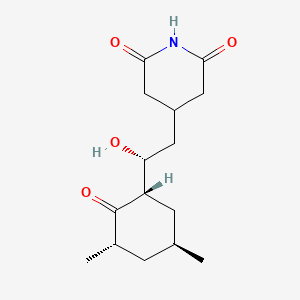D0164 | cycloheximide
| Toxicity | Dose | Time | Species | Model | Method | Action | Positive criterion | Reference |
|---|---|---|---|---|---|---|---|---|
| FERROPTOSIS | ferroptosis weak rescue | inhibitor | 245 | |||||
| Pictogram | Signal | Statements | Precautionary Statement Codes |
|---|---|---|---|
   |
Danger |
H300: Fatal if swallowed [Danger Acute toxicity, oral] H341: Suspected of causing genetic defects [Warning Germ cell mutagenicity] H360D ***: May damage the unborn child [Danger Reproductive toxicity] H411: Toxic to aquatic life with long lasting effects [Hazardous to the aquatic environment, long-term hazard] |
P201, P202, P264, P270, P273, P281, P301+P310, P308+P313, P321, P330, P391, P405, and P501; (The corresponding statement to each P-code can be found at the GHS Classification page.) |
    |
Danger |
Aggregated GHS information provided by 222 companies from 10 notifications to the ECHA C&L Inventory. Each notification may be associated with multiple companies. H300 (100%): Fatal if swallowed [Danger Acute toxicity, oral] H315 (17.12%): Causes skin irritation [Warning Skin corrosion/irritation] H341 (99.1%): Suspected of causing genetic defects [Warning Germ cell mutagenicity] H360 (99.55%): May damage fertility or the unborn child [Danger Reproductive toxicity] H411 (99.55%): Toxic to aquatic life with long lasting effects [Hazardous to the aquatic environment, long-term hazard] Information may vary between notifications depending on impurities, additives, and other factors. The percentage value in parenthesis indicates the notified classification ratio from companies that provide hazard codes. Only hazard codes with percentage values above 10% are shown. |
P201, P202, P264, P270, P273, P280, P281, P301+P310, P302+P352, P308+P313, P321, P330, P332+P313, P362, P391, P405, and P501; (The corresponding statement to each P-code can be found at the GHS Classification page.) |
   |
Danger |
H300: Fatal if swallowed [Danger Acute toxicity, oral] H341: Suspected of causing genetic defects [Warning Germ cell mutagenicity] H360D: May damage the unborn child [Danger Reproductive toxicity] H411: Toxic to aquatic life with long lasting effects [Hazardous to the aquatic environment, long-term hazard] |
P201, P202, P264, P270, P273, P281, P301+P310, P308+P313, P321, P330, P391, P405, and P501; (The corresponding statement to each P-code can be found at the GHS Classification page.) |
   |
Danger |
H300: Fatal if swallowed [Danger Acute toxicity, oral] H315: Causes skin irritation [Warning Skin corrosion/irritation] H319: Causes serious eye irritation [Warning Serious eye damage/eye irritation] H341: Suspected of causing genetic defects [Warning Germ cell mutagenicity] H360: May damage fertility or the unborn child [Danger Reproductive toxicity] |
P201, P202, P264, P270, P280, P281, P301+P310, P302+P352, P305+P351+P338, P308+P313, P321, P330, P332+P313, P337+P313, P362, P405, and P501; (The corresponding statement to each P-code can be found at the GHS Classification page.) |
| (1S-(1alpha(S*),3alpha,5beta))-4-(2-(3,5-Dimethyl-2-oxo-cyclohexyl))-2-hydroxyethyl-2,6-piperidinedione | .beta.-[2-(3,5-Dimethyl-2-oxocyclohexyl)-2-hydroxyethyl]glutarimide | 082C346 |
| 2, 4-[2-(3,5-dimethyl-2-oxocyclohexyl)-2-hydroxyethyl]-, [1S-[1.alpha.(S*),3.alpha.,5.beta.]]- | 2,6-Piperidinedione, 4-((2R)-2-((1S,3S,5S)-3,5-dimethyl-2-oxocyclohexyl)-2-hydroxyethyl)- | 2,6-Piperidinedione, 4-(2-(3,5-dimethyl-2-oxocyclohexyl)-2-hydroxyethyl)-, (1S-(1alpha(S*),3alpha,5beta))- |
| 3-((R)-2-((1S,3S,5S)-3,5-Dimethyl-2-oxocyclohexyl)-2-hydroxyethyl)glutarimide | 3-(2-(3,5-Dimethyl-2-oxocyclohexyl)-2-hydroxyethyl)glutarimide | 3-(2R)-2-((1S,3S,5S)-3,5-Dimethyl-2-oxocyclohexyl)-2-hydroxyethylglutarimide |
| 3-[2-(3,5-Dimethyl-2-oxocyclohexyl)-2-hydroxyethyl]glutarimide | 4-((2R)-2-((1S,3S,5S)-(3,5-Dimethyl-2-oxocyclohexyl))-2-hydroxyethyl)piperidine-2,6-dione | 4-((R)-2-((1S,3S,5S)-3,5-Dimethyl-2-oxocyclohexyl)-2-hydroxyethyl)piperidine-2,6-dione |
| 4-(2-(3,5-Dimethyl-2-oxocyclohexyl)-2-hydroxyethyl)-2,6-piperidinedione | 4-[(2R)-2-((1S,3S,5S)-3,5-dimethyl-2-oxocyclohexyl)-2-hydroxyethyl]azaperhydro ine-2,6-dione | 4-[(2R)-2-[(1S,3S,5R)-3,5-dimethyl-2-oxo-cyclohexyl]-2-hydroxy-ethyl]piperidine-2,6-dione |
| 4-[(2R)-2-[(1S,3S,5S)-3,5-Dimethyl-2-oxocyclohexyl]-2-hydroxyethyl]piperidine-2,6-dione | 4-[(2R)-2-[(1S,3S,5S)-3,5-dimethyl-2-oxo-cyclohexyl]-2-hydroxy-ethyl]piperidine-2,6-dione | 4-[2-(3,5-Dimethyl-2-oxo-cyclohexyl)-2-hydroxyethyl]-2,6-piperidinedione |
| 4-[2-(3,6-piperidinedione | 4-{(2R)-2-[(1S,3S,5S)-3,5-dimethyl-2-oxocyclohexyl]-2-hydroxyethyl}piperidine-2,6-dione | 5-21-13-00434 (Beilstein Handbook Reference) |
| 66-81-9 | 98600C0908 | AB00052279_08 |
| ACTIDIONE | AI3-15541 | AKOS024282670 |
| AS-14624 | Acti-Aid | Acti-Dione |
| Acti-dione BR | Acti-dione PM | Acti-dione TGF |
| Actidion | Actidione BR | Actidione PM |
| Actidione TGF | Actidone | Actispray |
| Aktidion | Aktidion [Czech] | BDBM50080528 |
| BI2521 | BP-12396 | BPBio1_000990 |
| BRD-K36055864-001-05-1 | BRD-K36055864-001-07-7 | BRD-K36055864-001-09-3 |
| BRD-K36055864-001-16-8 | BRN 0088868 | BSPBio_000900 |
| BSPBio_003159 | C-17728 | C-9217 |
| C06685 | C15H23NO4 | CAS-66-81-9 |
| CBC 500046 | CC-2256 | CC-26065 |
| CCG-39902 | CCRIS 937 | CHEBI:27641 |
| CHEMBL123292 | CS-4985 | CX |
| Caswell No. 270A | Cicloheximida | Cicloheximida [INN-Spanish] |
| Cicloheximide | Cicloheximide (INN) | Cicloheximide [INN] |
| Cicloheximidum | Cicloheximidum [INN-Latin] | Cyclohemimide |
| Cyclohexamide | Cycloheximid | Cycloheximide (USAN) |
| Cycloheximide [BSI:ISO] | Cycloheximide [USAN] | Cycloheximide solution, 0.1%, for microbiology |
| Cycloheximide solution, Ready-Made Solution, microbial, 100 mg/mL in DMSO, 0.2 mum filtered | Cycloheximide, 95% | Cycloheximide, >=93.0% (HPLC) |
| Cycloheximide, Antibiotic for Culture Media Use Only | Cycloheximide, Biotechnology Performance Certified | Cycloheximide, High Purity |
| Cycloheximide, PESTANAL(R), analytical standard | Cycloheximide, Streptomyces griseus | Cycloheximide, from microbial, >=94% (TLC) |
| D03625 | DSSTox_CID_4882 | DSSTox_GSID_24882 |
| DSSTox_RID_77565 | DTXSID6024882 | DivK1c_000050 |
| EINECS 200-636-0 | EPA Pesticide Chemical Code 043401 | FT 3422-2 |
| GNF-PF-5118 | GTPL5433 | Glutarimide, 3-(2-(3,5-dimethyl-2-oxocyclohexyl)-2-hydroxyethyl)- |
| HMS1570M22 | HMS1921L04 | HMS2092D10 |
| HMS2097M22 | HMS3714M22 | HMS500C12 |
| HSDB 1552 | HY-12320 | Hizarocin |
| IDI1_000050 | KBio1_000050 | KBio2_001824 |
| KBio2_004392 | KBio2_006960 | KBio3_002659 |
| KBioGR_001408 | KBioSS_001824 | KUC105858N |
| Kaken | L918 | LS-1558 |
| M01527 | MFCD00082346 | MLS001055333 |
| MLS002154001 | NARAMYCIN A | NCGC00017363-05 |
| NCGC00017363-06 | NCGC00017363-07 | NCGC00017363-08 |
| NCGC00017363-10 | NCGC00024910-01 | NCGC00024910-02 |
| NCGC00024910-03 | NCGC00024910-04 | NCGC00024910-05 |
| NCGC00024910-06 | NCGC00169964-05 | NCGC00257430-01 |
| NCGC00258710-01 | NCI60_001540 | NINDS_000050 |
| NM-MCD 80 | NSC 185 | NSC-185 |
| NSC-758187 | NSC185 | NSC758187 |
| Naramycin | Neocycloheximide | Pharmakon1600-01502112 |
| Prestwick0_000790 | Prestwick1_000790 | Prestwick2_000790 |
| Prestwick3_000790 | Prestwick_976 | Q412895 |
| SBB005972 | SBI-0051732.P002 | SC-19304 |
| SCHEMBL26617 | SMR000686067 | SPBio_000720 |
| SPBio_002839 | SPECTRUM1502112 | SR-01000597484 |
| SR-01000597484-1 | SR-01000597484-4 | SR-05000001596 |
| SR-05000001596-1 | SR-05000001596-3 | SR-05000001596-4 |
| ST057527 | Spectrum2_000900 | Spectrum3_001510 |
| Spectrum4_000914 | Spectrum5_001635 | Spectrum_001344 |
| TCMDC-125838 | TZA | Tox21_113580 |
| Tox21_113580_1 | Tox21_201158 | Tox21_303652 |
| U 4527 | U-4527 | UNII-98600C0908 |
| WLN: T6VMVTJ E1YQ- BL6VTJ D1 F1 | YPHMISFOHDHNIV-FSZOTQKASA-N | ZINC3872170 |
| ZX-AFC000592 | Zykloheximid | [1S-[1.alpha.(S*),3.alpha.,5.beta.]]-4-[2-(3,5-Dimethyl-2-oxocyclohexyl)-2-hydroxyethyl]-2,6-piperidinedione |
| beta-(2-(3,5-Dimethyl-2-oxocyclohexyl)-2-hydroxyethyl)glutarimide | cid_6197 | cycloheximide |
| ksc-8-190 |

